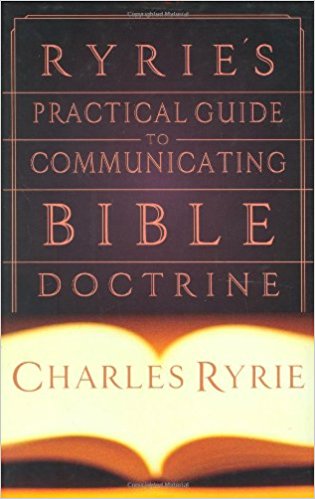By: Charles Fizer
The Apostle Paul emphasized the importance of Bible doctrine sixteen times in his letters to Timothy and Titus (I Timothy 1:3, 10; 4:6, 16). Bible doctrine is teaching exactly what the Scriptures reveal, whether it is objective truth or the practical commands they contain. In our desire to be “relevant” or “practical,” it is easy to make the Bible say what it really does not say! Our lives must be built on the doctrines in Scripture.
The Purpose of the Book
The late Dr. Charles Ryrie (1925-1916), long-time professor at Dallas Theological Seminary, was well known for his clear and effective Bible teaching. In his brief but excellent book, he helps us learn how to communicate Bible doctrine. He begins in chapter one by asking this question: “Since doctrine is so important and relevant, how then can I communicate the doctrines of Scripture so that they may become implanted in our minds and hearts and displayed in our lives?” (p. 9) After explaining why Bible doctrine is important, the writer outlines five different ways of communicating it clearly. These methods are: (1) using major Bible passages (2) using systematic theology (3) using Biblical Theology (4) using a concordance and (5) using Biblical illustrations.
Important Methods in Communicating Bible Doctrine
The method of using a major passage can be exemplified by studying Romans 3:21-26. By pointing out the confusion over the meaning of the word “justification,” one can explain why this truth is so vitally important. Ryrie rightly points out that justification is not “making” a person righteous in the sight of God but “declaring” that person righteous in His sight. This key passage teaches that righteousness is given to a person through faith in Christ’s death as a free gift.
Systematic theology is another way to teach Bible doctrine. He defines systematic theology as “the correlation of biblical information as a whole in order to explain and exhibit systematically the total material of various aspects of God’s revelation.” (p. 21) In the past some have decried systematizing the truth. In reality, it is a good way to compare Scripture with Scripture. Ryrie uses the doctrine of the Holy Spirit as an example. All the references to the Holy Spirit in the New Testament can be put together for insight into the Spirit’s person and work.
A third way to communicate biblical truth is by biblical theology. This “theology pays careful attention to the fact that God’s revelation was embodied in history.” (p. 30) The times, the revealed truth about the author, and the circumstances can be addressed to bring understanding to a particular section of Scripture. The author uses a fascinating example of “The Doctrine of Inspiration in the Letter of James,” in which he demonstrates James’s view of inspiration and his use of the Word of God.
A fourth way to communicate doctrine is by collecting references from a concordance. If the student understands Greek and Hebrew (which most of us do not!) he should use a concordance based on the original words. Others can use an English concordance, remembering that some translations use different English words to translate the same Greek or Hebrew word. He does not mention Bible software programs that are available for Bible students today.
The last approach is that of using biblical illustrations. Examples like “the potter and the clay”, “salt and light”, “birds and flowers” and “the lost coin” are given to show how images and pictures can teach important doctrinal lessons. The author of this review found the chapter entitled “Of the Making of Principles There Seems to Be No End” very helpful. Ryrie addresses the problem of attempting to make a text of Scripture teach something that really is not in the text. Helpful guidelines for proper recognition of principles are given in this chapter. The importance of expository teaching and preaching is also addressed in a clear and stimulating way.
This book is highly recommended for those who teach and preach the Word. But the book may be useful even for those who do not have these spiritual gifts, they, too can be better prepared to evaluate what he or she hears by reading this book.

